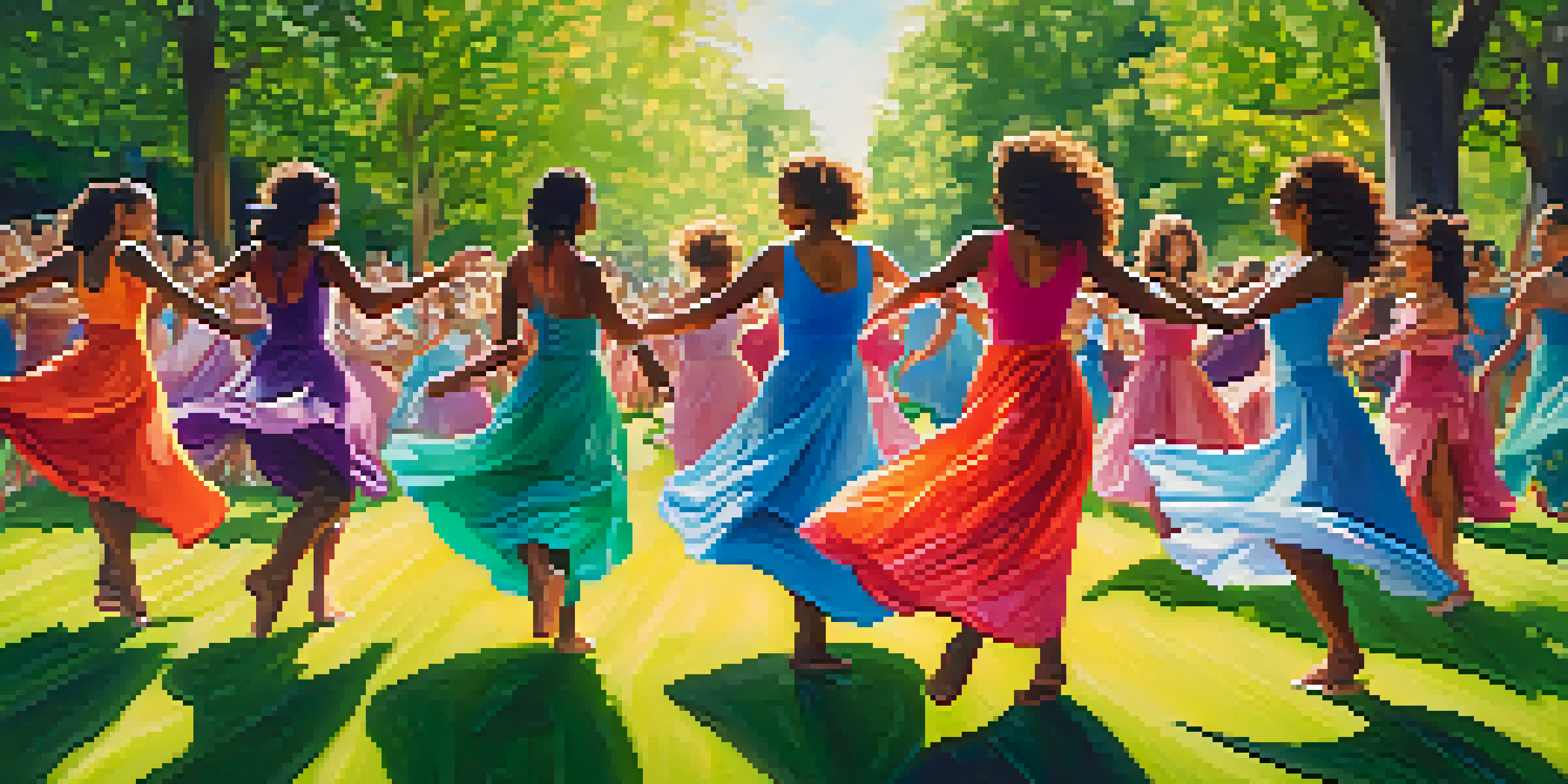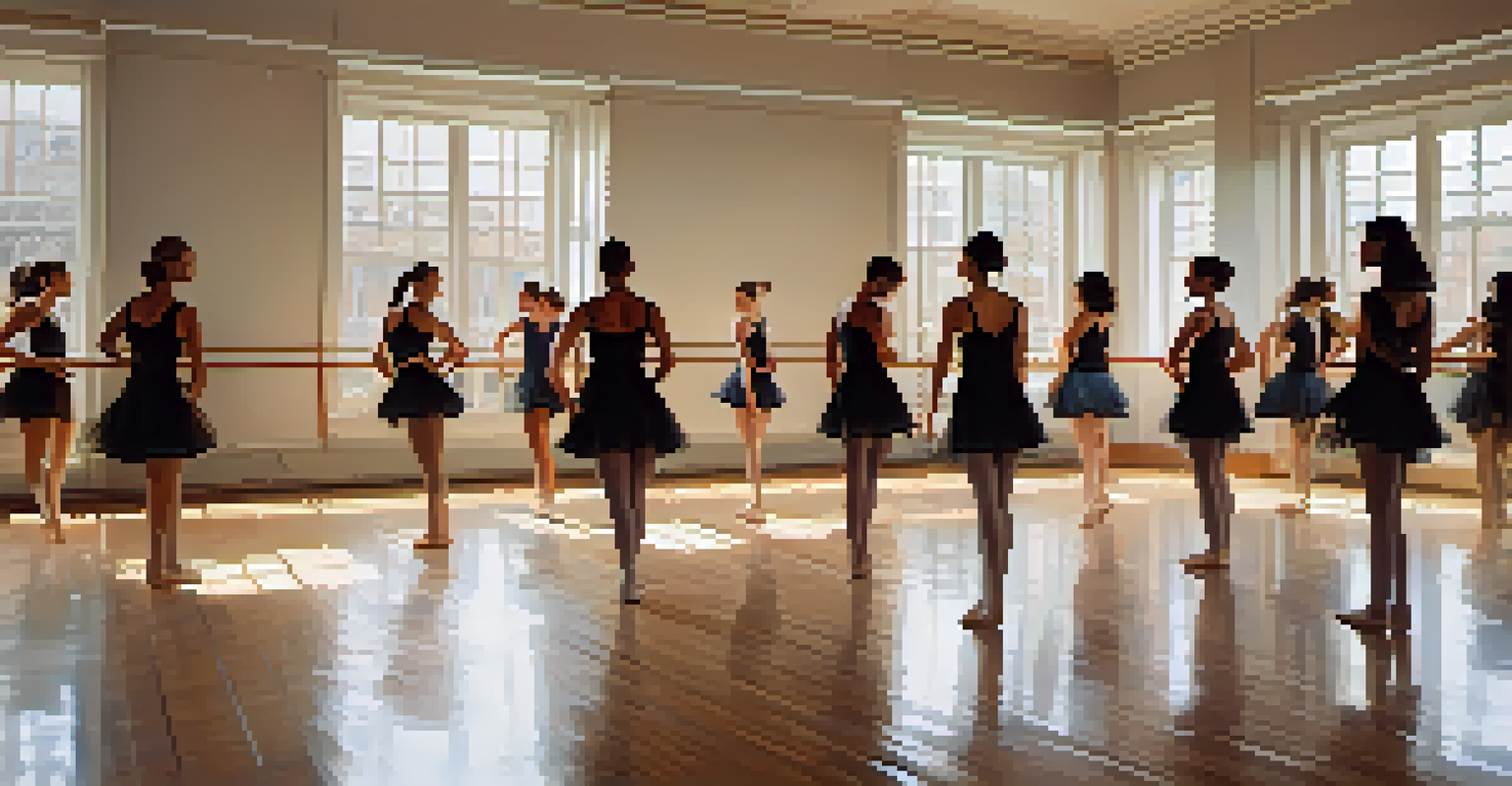Feminist Dance Movements: Art as a Tool for Change

The Intersection of Feminism and Dance
Feminist dance movements blend artistry with activism, creating a powerful platform for expression. These movements often challenge traditional gender roles, using the body as a means of communication. By breaking free from conventional dance forms, artists create spaces that celebrate women's experiences and struggles.
Dance is the hidden language of the soul.
For instance, the work of choreographers like Pina Bausch has redefined how we perceive dance, emphasizing emotional depth and personal narrative. This approach invites audiences to engage more meaningfully with the performance, fostering a sense of empathy and understanding. As a result, the intersection of feminism and dance becomes a dynamic space for dialogue and reflection.
Ultimately, this blend encourages both performers and viewers to question societal norms, paving the way for broader discussions about gender, power, and identity. The dance floor transforms into a stage for activism, where every movement tells a story of resilience and empowerment.
Historical Context of Feminist Dance
Feminist dance movements have roots in the broader feminist movement of the 1960s and 70s. During this time, women began to assert their voices in various art forms, challenging the male-dominated narratives of the past. This era saw significant shifts in how dance was perceived, as choreographers started incorporating political themes into their work.

One pivotal moment was the emergence of performance art, where women like Yoko Ono and Marina Abramović used their bodies to challenge societal expectations. These artists not only redefined dance but also expanded its boundaries, inviting audiences to engage with provocative themes like identity and sexuality. This historical context laid the groundwork for future generations of feminist dancers.
Feminism Empowers Dance as Activism
Feminist dance movements blend artistry with activism, using the body to challenge societal norms and express resilience.
As we look back, it's clear that these early movements set the stage for contemporary feminist dance, which continues to evolve and inspire. The legacy of these pioneers reminds us of the essential role art plays in advocating for social change.
Prominent Feminist Dance Companies
Numerous dance companies today embody feminist principles, using their platforms to raise awareness and challenge societal norms. Companies like the Liz Lerman Dance Exchange focus on community engagement and social issues, fostering conversations through movement. Their performances invite audience members to participate, bridging the gap between artist and viewer.
Art is not freedom from discipline, but disciplined freedom.
Another notable group is the all-female troupe, The Women’s Project, which showcases the work of female choreographers and emphasizes women's stories. Their commitment to representing diverse perspectives enriches the dance community and challenges conventional narratives. Through their performances, these companies highlight the importance of inclusivity and representation in the arts.
By showcasing a range of voices and experiences, these feminist dance companies encourage audiences to reconsider their perceptions of gender and power. Their work not only entertains but also educates, making art a vehicle for meaningful change.
Dance as a Form of Activism
Dance serves as a unique form of activism, allowing individuals to express discontent and advocate for social justice. Through movement, dancers can convey powerful messages without uttering a single word, tapping into universal emotions. This non-verbal communication can resonate deeply with audiences, creating a shared understanding of complex issues.
For example, flash mobs have been used to protest against violence towards women, turning public spaces into stages for advocacy. These spontaneous performances draw attention to urgent social issues, demonstrating how art can mobilize communities. By transforming everyday locations into sites of resistance, dancers amplify their voices and inspire action.
Intersectionality Enriches Dance
Embracing intersectionality allows feminist dance to reflect diverse identities and foster solidarity among different communities.
In this way, dance transcends its artistic boundaries, becoming a tool for social commentary and change. It encourages participants and spectators alike to reflect on their roles in society and consider how they can contribute to a more equitable world.
The Role of Intersectionality in Dance
Intersectionality plays a crucial role in feminist dance movements, highlighting how different identities intersect to shape individual experiences. Recognizing that gender is not the only factor influencing a person's life, feminist dance embraces a variety of perspectives, including race, class, and sexuality. This inclusivity enriches the narrative and broadens the conversation surrounding feminism.
For instance, choreographers like Alesandra Seutin incorporate African and Caribbean dance styles, acknowledging the diverse cultural influences that shape contemporary dance. By celebrating these varied backgrounds, artists create a more holistic understanding of feminism that resonates with a broader audience. This approach fosters solidarity among different communities, allowing for shared experiences and understanding.
Ultimately, embracing intersectionality in dance not only empowers marginalized voices but also challenges the dominant narratives within the artistic community. It encourages a more nuanced conversation about feminism, making the movement more inclusive and impactful.
The Impact of Technology on Feminist Dance
Technology has transformed the way dance is created and consumed, offering new avenues for feminist expression. Digital platforms allow artists to reach wider audiences, breaking geographical barriers and promoting diverse voices. Social media, in particular, has become a vital space for sharing performances and amplifying feminist messages.
For example, platforms like Instagram have enabled dancers to showcase their work and connect with like-minded artists globally. This online visibility can spark conversations and inspire action, as individuals share their experiences and stories. Additionally, technology facilitates collaboration, allowing dancers from different backgrounds to work together and create innovative pieces that reflect a range of perspectives.
Technology Expands Dance's Reach
Digital platforms enhance the visibility of feminist dance, enabling artists to share their messages and collaborate globally.
As technology continues to evolve, it opens up exciting possibilities for feminist dance movements. By harnessing these tools, artists can create impactful work that resonates with audiences and drives social change.
Future Directions for Feminist Dance Movements
As feminist dance movements evolve, they continue to adapt to the changing social landscape and address emerging issues. The future holds immense potential for innovation, as artists explore new forms and platforms for expression. This adaptability ensures that feminist dance remains relevant and impactful in advocating for social change.
One exciting direction is the increased focus on mental health and body positivity within feminist dance. Choreographers are increasingly incorporating themes that promote self-acceptance and challenge beauty standards, fostering a more inclusive environment. This shift not only empowers dancers but also resonates with audiences who seek to find their own voices in a society often defined by unrealistic ideals.

Looking ahead, the integration of technology and cross-disciplinary collaboration will likely play a significant role in shaping feminist dance. As artists continue to push boundaries and explore new avenues of expression, we can expect to see an even richer tapestry of stories that reflect the diverse experiences of women and marginalized communities.